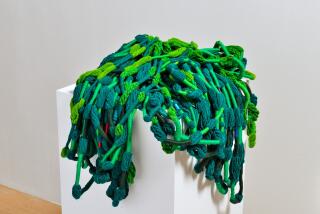DECORATING : Traditional Quilt Patterns Surfacing in Low, High Places
Early American patchwork quilts were made of necessity from scraps of cloth. Then patchwork was elevated to an art as wall hangings. Now, century-old patchwork designs are being translated onto modern countertops, walls and floors.
âQuilt patterns are graphically interesting, and they mix well with so many periods of furnishings,â Lili Lihn says, noting that there are more than 4,000 documented patterns to work from.
Lihn, a consultant in New York, came up with an idea for a kitchen island countertop with traditional patchwork patterns at the corners. The counter is made of Avonite, an acrylic solid-surfacing material. The patchwork patterns, in black and almond on a white ground, include the nine bells and the fan.
Although Lihnâs work was intricate with expensive round cuts, simpler and less expensive patterns of squares and triangles could be equally effective on any solid surfacing material. Since most materials come in a wide range of colors, the variety of effects is almost infinite.
The secret of a good pattern, Lihn says, is a mix of light, medium and dark colors. As with quilts, the most dramatic effects come with simple shapes, interesting color contrasts and pattern repetition.
Crossville Ceramics of Crossville, Tenn., designs traditional American quilting patterns in porcelain tile for floors and walls.
âPatchwork motifs are warm and friendly,â says Barbara Schirmeister of New York, a design consultant who originated the patchwork idea for Crossville. Working through a local distributor, a homeowner can have a border or a complete floor made by Crossville from one of 17 American quilt patterns and 33 color choices. Or the client may order a custom pattern, including an original patchwork design if the pattern is simple.
Jim Dougherty, Crossvilleâs vice president of sales and marketing, says patchwork tile patterns are being used in kitchens, family rooms and entryways. Prices range from $20 to $25 a square foot and $12 to $15 a running foot for a six-inch-wide border. A 3-by-5-foot ârugâ might cost $300 using only straight cuts. As with the Avonite countertop, round cuts are significantly more expensive.
Schirmeister says an âarea rugâ set within a solid-color tile floor is highly effective. Patterned porcelain tiles can also be used as a center motif on a kitchen counter or as a border on a wall or floor. More unusual is a patchwork border around a fireplace or a center motif cut into a butcher block countertop.
Color can drastically affect the pattern.
âA monochromatic scheme is more subdued, great for a bathroom,â Schirmeister says. âThe same pattern in an entryway with three bold colors or with two highly contrasting colors such as red and white would be more dramatic.â
Simple geometric patterns such as the star, log cabin and diamond quilt patterns, translate best for floor and counter. Others, such as the wedding ring and Sunbonnet Sue, can be used but are more complicated.
Armstrongâs Color Passion vinyl sheet flooring, available in 30 solid colors, can be worked by professional installers into many quilt patterns, says Thomas Hills Cook, the companyâs interior designer.
Patchwork has even spread to commercial settings. Interior designer Barbara Lazaroff used Italian ceramic tiles for patchwork floor patterns at Wolfgang Puck cafes.
Lazaroff says she was looking for a pattern that wasnât too commercial and appealed to a broad spectrum of customers. She says patchwork quilts are an indigenous art form in the United States so they represent ârootsâ for many Americans.
âAnd they are very comforting,â she says, âlike mashed potatoes and ice cream.â
*
Additional information is available from Avonite (505) 864-3800; Crossville, (615) 484-2110, and Armstrong, (800) 233-3823.


